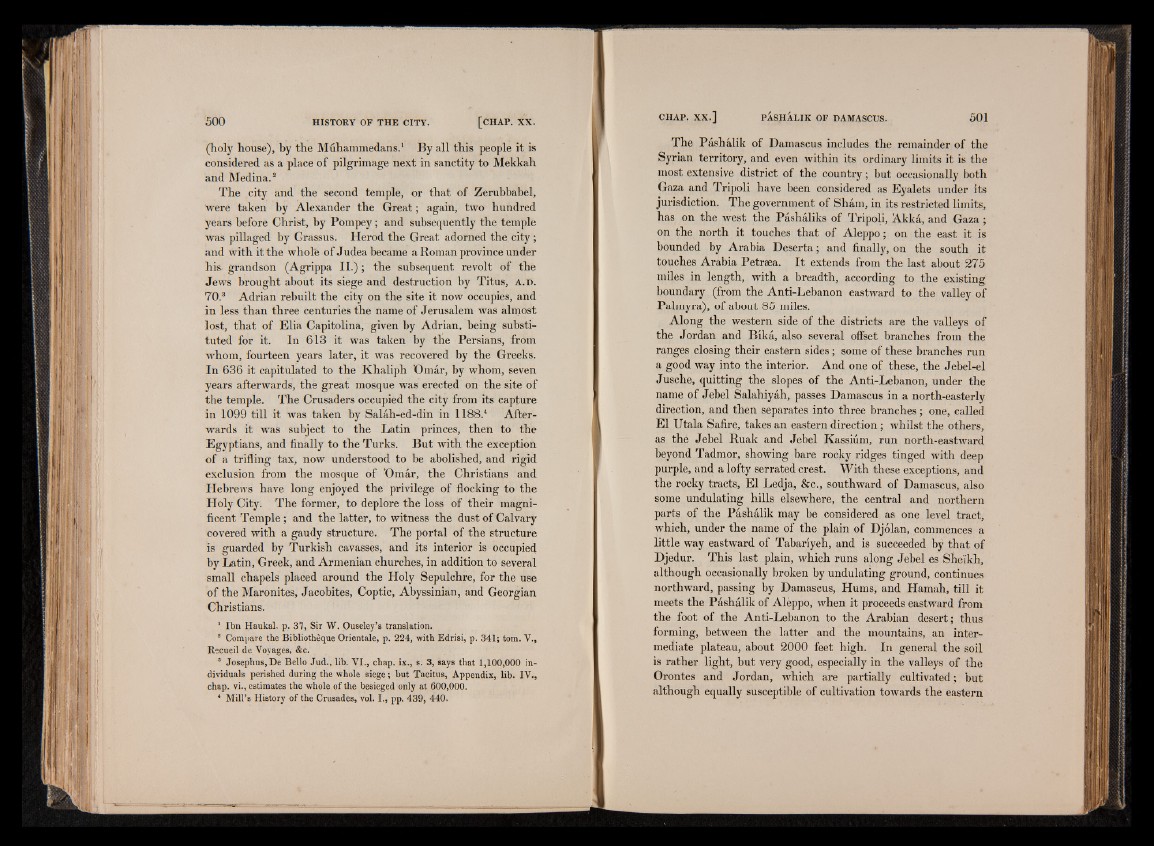
(holy house), by the Muhammedans.1 By all this people it is
considered as a place of pilgrimage next in sanctity to Mekkah
and Medina.8
The city and the second temple, or that of Zerubbabel,
were taken by Alexander the Great ; again, two hundred
years before Christ, by Pompey ; and subsequently the temple
was pillaged by Grassus. Herod the Great adorned the city ;
and with it the whole of Judea became a Roman province under
his- grandson (Agrippa II.) ; the subsequent revolt of the
Jews brought about its siege and destruction by Titus, A.D.
70.3 Adrian rebuilt the city on the site it now occupies, and
in less than three centuries the name of Jerusalem was almost
lost, that of Elia Capitolina, given by Adrian, being substituted
for it. In 613 it was taken by the Persians, from
whom, fourteen years later, it was recovered by the Greeks.
In 636 it capitulated to the Khaliph ’Omar, by whom, seven
years afterwards, the great mosque was erected on the site of
the temple. The Crusaders occupied the city from its capture
in 1099 till it was taken by Salâh-ed-din in 1188.4 Afterwards
it was subject to the Latin princes, then to the
Egyptians, and finally to the Turks. But with the exception
of a trifling tax, now understood to be abolished, and rigid
exclusion from the mosque of ’Omar, the Christians and
Hebrews have long enjoyed the privilege of flocking to the
Holy City. The former, to deplore the loss of their magnificent
Temple ; and the latter, to witness the dust of Calvary
covered with a gaudy structure. The portal of the structure
is guarded by Turkish cavasses, and its interior is occupie4
by Latin, Greek, and Armenian churches, in addition to several
small chapels placed around the Holy Sepulchre, for the use
of the Maronites, Jacobites, Coptic, Abyssinian, and Georgian
Christians.
1 Ibn Haukal. p, 37, Sir W. Ouseley’s translation.
s Compare the Bibliothèque Orientale, p. 224, with Edrisi, p. 341; tom. V.,
Recueil de Voyages, &c.
3 Josephus,De Bello Jud., lib. VI., chap. ix., s. 3, says that 1,100,000 individuals
perished during the whole siege ; but Tacitus, Appendix, lib. IV.,
chap. vi., estimates the whole of the besieged only at 600,000.
* Mill’s History of the Crusades, vol. I., pp. 439, 440.
The Pashalik of Damascus includes the remainder of the
Syrian territory, and even within its ordinary limits it is the
most extensive district of the country; but occasionally both
Gaza and Tripoli have been considered as Eyalets under its
jurisdiction. The government of Sham, in its restricted limits,
has on the west the Pashaliks of Tripoli, Akka, and Gaza ;
on the north it touches that of Aleppo; on the east it is
bounded by Arabia Deserta; and finally, on the south it
touches Arabia Petrsea. It extends from the last about 275
miles in length, with a breadth, according to the existing
boundary (from the Anti-Lebanon eastward to the valley of
Palmyra), of about 85 miles.
Along the western side of the districts are the valleys of
the Jordan and Bika, also several offset branches from the
ranges closing their eastern sides; some of these branches run
a good way into the interior. And one of these, the Jebel-el
Jusche, quitting the slopes of the Anti-Lebanon, under the
name of Jebel Salahiyah, passes Damascus in a north-easterly
direction, and then separates into three branches; one, called
El Utala Safire, takes an eastern direction; whilst the others,
as the Jebel Ruak and Jebel Kassium, run north-eastward
beyond Tadmor, showing bare rocky ridges tinged with deep
purple, and a lofty serrated crest. With these exceptions, and
the rocky tracts, El Ledja, &c., southward of Damascus, also
some undulating hills elsewhere, the central and northern
parts of the Pashalik may be considered as one level tract,
which, under the name of the plain of Djolan, commences a
little way eastward of Tabariyeh, and is succeeded by that of
Djedur. This last plain, which runs along Jebel es Sheikh,
although occasionally broken by undulating ground, continues
northward, passing by Damascus, Hums, and Hamah, till it
meets the Pashalik of Aleppo, when it proceeds eastward from
the foot of the Anti-Lebanon to the Arabian desert; thus
forming, between the latter and the mountains, an intermediate
plateau, about 2000 feet high. In general the soil
is rather light, but very good, especially in the valleys of the
Orontes and Jordan, which are partially cultivated ; but
although equally susceptible of cultivation towards the eastern